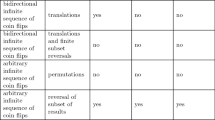Abstract
In finite probability theory, the only probability zero event is the impossible one, but in standard Kolmogorov probability theory, probability zero events occur all the time. Prominent logicians, probability experts and philosophers of probability, including Carnap, Kemeny, Shimony, Savage, De Finetti, Jeffrey, have successfully argued that a sound probability should be regular, that is, only the impossible event should have zero probability. This intuition is shared by physicists too. Totality is another desideratum which means that every event should be assigned a probability. Regularity and totality are achievable in rigorous mathematical terms even for infinite events via hyper-reals valued probabilities. While the mathematics of these theories is not objectionable, some philosophical arguments purport to show that infinitesimal probabilities are inherently problematic. In this paper, we present a simpler and natural construction—based on Sergeyev’s calculus with Grossone (in a formalism inspired by Lolli) enriched with infinitesimals—of a regular, total, finitely additive, uniformly distributed probability on infinite sets of positive integers. These probability spaces—which are inspired by and parallels the construction of classical probability—will be briefly studied. In this framework, De Finetti fair lottery has the natural solution and Williamson’s objections against infinitesimal probabilities are mathematically refuted.
Similar content being viewed by others
Notes
This is a special case of the Euclidean principle requiring that any set should have a strictly larger probability than each of its strict subsets. It is easy to see that every regular, total and finitely additive probability is Euclidean: indeed, for all \(X,Y \subseteq \varOmega \), if \(X\subset Y\), then because \(Y= X \cup (Y{{\setminus}} X)\) and \(Y{{\setminus}} X \not = \emptyset \), then by finite additivity of the mutually disjoints events X and Y, we have: \(\Pr (Y) = \Pr (X) + \Pr (Y{\setminus} X)> \Pr (X)\) as \( \Pr (Y{\setminus} X)>0\).
A more general, but less formal, form is to ask that the probability theory should allow for a mathematical representation of any probabilistic situation that is conceptually possible.
The name “measure” will be justified by Theorem 1.
An informal discussion of a probability on a set with more than \(\textcircled {1}\) elements is presented in Section 9.1 [6].
In case \(\varOmega \) is contextually clear \({\Pr }_\varOmega \) will be simply written \(\Pr \).
References
Benci V, Horsten L, Wenmackers S. Infinitesimal probabilities. Brit J Phil Sci. 2018;69:509–52.
Olofsson P. Probability, statistics, and stochastic processes. New York: Wiley Interscience; 2005.
Sergeyev YD. Arithmetic of infinity. Cosenza: Edizioni Orizzonti Meridionali; 2003.
Sergeyev YD. A new applied approach for executing computations with infinite and infinitesimal quantities. Informatica. 2008;19(4):567–96.
Sergeyev YD. Computations with grossone-based infinities. In: Calude CS, Dinneen MJ (eds) Unconventional Computation and Natural Computation—14th International Conference, UCNC 2015, Auckland, New Zealand, 2015, Proceedings, Springer, Lecture Notes in Computer Science, vol 9252, pp 89–106. 2015. https://doi.org/10.1007/978-3-319-21819-9_6
Sergeyev YD. Numerical infinities and infinitesimals: methodology, applications, and repercussions on two Hilbert problems. EMS Surv Math Sci. 2017;4(2):219–320.
Lolli G. Metamathematical investigations on the theory of grossone. Appl Math Comput. 2015;255:3–14.
Williamson T. How probable is an infinite sequence of heads? Analysis. 2007;67:173–80.
Nelson E. Radically elementarry probability theory. Princeton: Princeton University Press; 1987.
Wenmackers S, Horsten L. Fair infinite lotteries. Synthese. 2013;190:37–61.
Benci V, Horsten L, Wenmackers S. Non-arhimedian probability. Milan J Math. 2013;81:121–51.
Gilbert T, Rouche N. Y a-t-il vraiment autant de nombres pairs que de naturels? Cahiers Centre Logique. 1996;9:99–139.
Benci V, Nasso MD, Forti M. An aristotelian notion of size. Ann Pure Appl Logic. 2006;143(1):43–53. https://doi.org/10.1016/j.apal.2006.01.008, http://www.sciencedirect.com/science/article/pii/S016800720600042X.
De Finetti B. Theory of Probability. London, New York, Sydney, Toronto: Wiley; 1975.
Truss J. Foundations of mathematical analysis. Oxford: Oxford University Press; 1997.
Rizza D. Numerical methods for infinite decision-making processes. Int J Unconvent Comput. 2019;14(2):139–58.
Lolli G. Infinitesimals and infinites in the history of mathematics: a brief survey. Appl Math Comput. 2012;218(16):7979–88.
Parker MW. Symmetry arguments against regular probability: a reply to recent objections. Eur J Philos Sci. 2018;9(8):1–21. https://doi.org/10.1007/s13194-018-0229-1.
Mermin ND. Physics: Qbism puts the scientist back into science. Nature. 2014;507:421–3. https://doi.org/10.1038/507421a.
Ellerman D. On classical finite probability theory as a quantum probability calculus. 2015. arXiv:1502.01048
Khrennikov A. Quantum bayesianism as the basis of general theory of decision-making. Philos Trans A Math Phys Eng Sci. 2016;374(2068):20150245. https://doi.org/10.1098/rsta.2015.0245.
Acknowledgements
We thank Yaro Sergeyev and Anatoly Zhigljavsky for comments and suggestions which improved this paper and Gabrielle Lolli for illuminating discussions on his paper [7], infinitesimals and Grossone. We also thank Elena Calude for asking challenging questions which improved our model.
Author information
Authors and Affiliations
Corresponding author
Ethics declarations
Conflict of interest
On behalf of all the authors, the corresponding author states that there is no conflict of interest.
Additional information
Publisher's Note
Springer Nature remains neutral with regard to jurisdictional claims in published maps and institutional affiliations.
Rights and permissions
About this article
Cite this article
Calude, C.S., Dumitrescu, M. Infinitesimal Probabilities Based on Grossone. SN COMPUT. SCI. 1, 36 (2020). https://doi.org/10.1007/s42979-019-0042-8
Received:
Accepted:
Published:
DOI: https://doi.org/10.1007/s42979-019-0042-8




